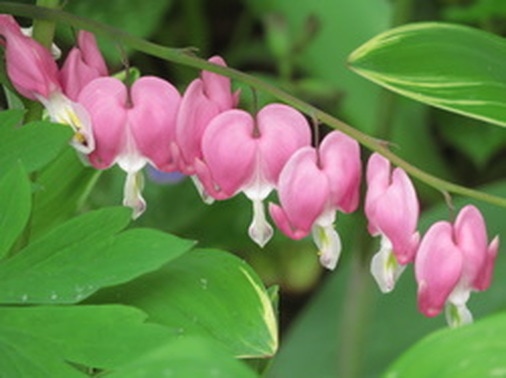Bleeding heart (Lamprocapnos spectabilis)
|
Bleeding Heart (Lamprocapnos spectabilis)
Genus: Lamprocapnos Family: Papaveraceae Species: spectabilis (synonym - dicentra spectabilis) Type: Perennial Hardiness: Zone: 3 - 9 Bloom Time: mid to late spring. Exposure: Partial to full shade. Height: 24-36 inches Spread: 18-30 inches. Description: Puffy, heart-shaped, rose-pink flowers with protruding white inner petals begin bloom in spring before the leaves emerge. Flowers dangle downward at regular intervals beneath long arching stems. Compound, biternate green leaves. Cultivation: Protect from hot afternoon sun. Flowering is best with morning sun and afternoon shade. After flowering, Bleeding Heart should be cut back to rejuvenate the foliage. Even so, these often go completely dormant by midsummer, to return again the following spring. Remove dead foliage after a killing frost in autumn, or anytime it becomes unattractive. A light mulch after the ground freezes will protect from winter heaving. Fertilizer/Soil and pH/Watering: These plants are at their best in evenly moist, rich soil A two-inch layer of mulch will help buffer soil moisture and keep the ground cooler. A slightly acidic soil (pH 6.0 to 6.5) is ideal, but plants will tolerate a pH up to 7.5. Apply a light application of balanced or slow-release fertilizer or side-dress with compost and organic amendments when new growth appears. Water well if it is unseasonably dry, as plants prefer evenly moist soil. Water consistently - D. spectabilis will go dormant during dry conditions in summer. Pests/Diseases: Dicentra is occasionally bothered by slugs and snails. Treat accordingly with baits or by handpicking. If grown in poorly drained, wet soil, the crowns of the plants may rot. Avoid these soils and allow good air circulation. Keep mulch several inches away from the base/crowns of the plants. Reflowering: The smaller varieties of Dicentra will bloom right up until frost in temperate climates, especially if old flower stems are removed. In areas with very hot summers, flowering may stop but will resume with cooler weather. Regular removal of yellowing foliage will keep plants looking fresh. Propogation/Transplanting: Divide or transplant if needed as soon as you see new growth. IPlants can be gingerly divided in early spring; gently separate the brittle roots, replanting vigorous pieces from the outer edge of the plant. Notes/Gardening Tips: Native to Japan. |

